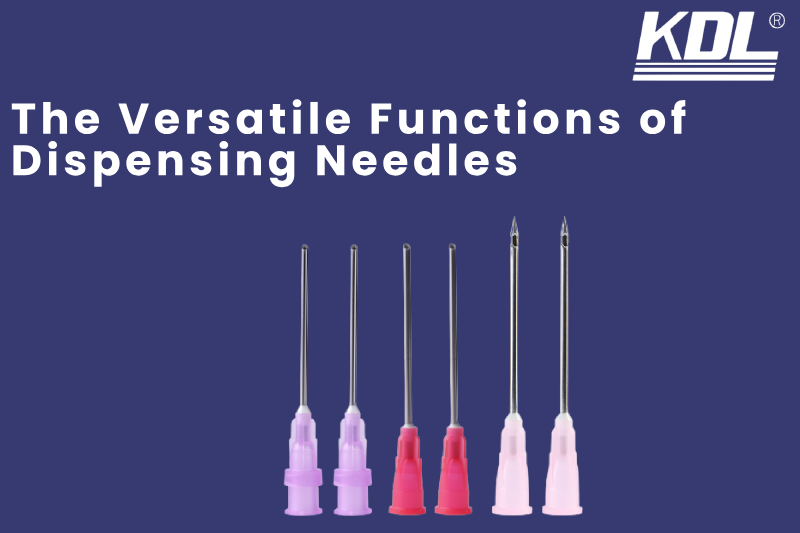
Dispensing needles might appear as unassuming tools, but their significance spans across a myriad of industries, quietly enabling processes that demand precision, accuracy, and controlled liquid handling. Whether you’ve marvelled at the delicate frosting on a cake, received a painless subcutaneous injection, or wondered about the intricacies of electronics manufacturing, dispensing needles have played an integral role.
In this blog post, we embark on a journey to unravel the versatile functions of these unassuming yet indispensable devices. From medical marvels to culinary creations, and from intricate electronics to personal care products, let’s delve into the intricate world of dispensing needles, understanding how they facilitate a wide range of tasks with finesse and finesse.
Understanding Dispensing Needles

Dispensing needles are precision instruments designed to dispense liquids with controlled accuracy and consistency. They are commonly used across various industries where precise liquid handling is essential. The functions and features of these needles are meticulously engineered to ensure that the right amount of liquid is dispensed at the right place, at the right time.
Key aspects that make up the anatomy of dispensing needles and how they contribute to their versatile functions
Dispensing Needles Materials and Construction
Dispensing needles come in a range of materials, like stainless steel dispensing needles, plastics, and ceramics. The material used impacts the needle’s durability, chemical resistance, and its ability to handle varying viscosities. Additionally, the design of the needle tip plays a crucial role in determining the droplet size and precision of dispensing.
Dispensing Needle Sizes and Gauges
Dispensing needles come in various sizes and gauges, denoted by a numerical value. The gauge represents the diameter of the needle, with smaller numbers indicating larger diameters. Choosing the right needle size is essential as it affects factors such as flow rate, precision, and the type of substance being dispensed. For instance, a thicker needle might be suitable for more viscous liquids, while a finer needle is ideal for intricate applications that demand precision.
Dispensing Needle Tips Designs

The dispensing tips of a dispensing needle can have different designs, each tailored to specific applications. Tapered tips are commonly used for controlled dispensing and reduced dripping, while beveled tips offer a balance between precision and speed. Blunt tips dispensing needle are suitable for applications where the needle needs to come into contact with surfaces without puncturing them. KDL is China top manufacturer of dispensing needle with different types and different dispensing needle sizes and gauges.
Dispensing needles Control Mechanisms
Dispensing needles often incorporate mechanisms to control the flow of liquid. These mechanisms ensure that liquids are dispense consistently without dripping or excess flow. Anti-drip coatings and mechanisms prevent wastage and contribute to the precision of the dispensing process.
Dispensing needles Attachment and Compatibility
Dispensing needles are designed to be compatible with various dispensing systems, such as syringes or automated dispensing equipment. They are attached securely to these systems to facilitate precise liquid handling
The Range of Functions Dispensing Needles Serve
Dispensing needles might appear simple, but their ability to perform a diverse range of functions across industries is nothing short of remarkable. These slender tools are at the heart of precision liquid handling, contributing to the efficiency, accuracy, and quality of various processes.
Multifaceted functions that dispensing needles serve
Precision Liquid Dispensing
One of the primary functions of dispensing needles is to ensure precise liquid dispensing. The diameter of the needle, combined with the viscosity of the liquid, determines the size of the droplets or the volume of liquid dispensed. This function is critical in applications where exact quantities are require, such as in medical drug administration, where precise dosages are essential for patient safety.
Accurate Flow Control
Dispensing needles play a pivotal role in controlling the flow rate of liquids. The inner diameter of the needle, the material’s properties, and the needle’s design influence the speed at which the liquid is dispensed. Industries like electronics rely on consistent flow rates to apply adhesives and coatings accurately, ensuring product reliability and functionality.
Minimizing Waste and Drips
Anti-drip mechanisms and coatings are integrated into dispensing needle designs to minimize excess dripping or leaking after dispensing. This function is especially valuable in applications where liquid waste can result in significant costs or compromise product quality. By reducing wastage, dispensing needles help industries achieve better efficiency and resource management.
Chemical Compatibility
Dispensing needles are crafted from materials that can withstand a wide range of liquids, including corrosive, abrasive, or reactive substances. The chemical compatibility of the needle material is crucial to ensure the accurate dispensing of various fluids without compromising the needle’s integrity. This function is vital in industries like pharmaceuticals, where the compatibility of the needle with medications is critical.
Controlled Pattern Dispensing
In applications like printing and decorating, dispensing needles enable controlled pattern dispensing. By varying the pressure and movement of the needle, intricate designs, fine lines, and shapes can be accurately create. This function finds use in industries ranging from textile printing to the automotive sector for tasks like adding intricate designs to car interiors.
High-Speed Dispensing
For industries that require rapid and high-volume liquid dispensing, specialize dispensing needles are design to accommodate such demands. These needles maintain precision and accuracy even at high speeds, making them valuable in processes like high-speed manufacturing and packaging.
Sub-Microliter Dispensing
In fields where extremely small amounts of liquid need to be dispense, such as microfluidics and biotechnology, dispensing needles with ultra-fine gauges are employed. These needles enable the accurate manipulation of minuscule volumes, advancing research and development in areas like medical diagnostics and molecular biology.
Layered Dispensing and Coating
In industries like 3D printing and electronics, dispensing needles are use for layered deposition and coating processes. They apply precise layers of materials, enabling the creation of intricate structures and circuits with exact dimensions and specifications.
From healthcare to manufacturing, culinary arts to cosmetics, the functions performed by dispensing needles are remarkably diverse. Their role in ensuring accuracy, consistency, and quality has paved the way for innovation and advancements in numerous industries.
Choosing the Right Dispensing Needles for Your Needs
Selecting the appropriate dispensing needle is a crucial step in ensuring the success of your application. With a wide array of needle types, sizes, and materials available, making an informed choice can greatly impact the precision, efficiency, and quality of your processes. Here’s a guide to help you navigate the process of choosing the right dispensing needle for your specific needs
Factors to Consider When Choosing a Dispensing Needles
Selecting the right dispensing needle involves a thoughtful evaluation of various factors to ensure optimal performance and precision. The right needle can make a significant difference in achieving accurate liquid dispensing and maintaining process efficiency. Here are the key factors to consider when making your choice:
1.Fluid Properties
Understand the characteristics of the liquid you’ll be dispensing. Consider its viscosity, density, and whether it’s abrasive, corrosive, or reactive. Different fluids require needles with specific properties to ensure smooth and accurate dispensing.
2.Needle Gauge and Diameter
The gauge of the needle determines its diameter, which directly impacts the flow rate and precision of dispensing. Smaller gauge needles have finer tips and are suitable for lower flow rates and more precise applications, while larger gauges allow for faster flow.
3.Needle Length
The length of the needle affects how deep it can reach into containers or surfaces. Longer needles are useful for accessing hard-to-reach areas, while shorter ones are more maneuverable in confined spaces.
4.Tip Design
Different tip designs serve specific purposes. Tapered tips offer controlled dispensing, while beveled tips balance precision and flow. Blunt tips are suitable for gentle contact with surfaces. Choose a tip design that aligns with your application’s requirements.
5.Material Compatibility
Ensure that the needle material is compatible with the liquid you’re dispensing. Some liquids may react with certain materials, leading to degradation or contamination. Stainless steel, plastic, and ceramics are common needle materials with varying levels of compatibility.
6.Precision Requirements
Consider the level of precision your application demands. If you need to dispense tiny volumes accurately, opt for a fine gauge needle with a tapered tip. For applications that allow slight variations, a broader gauge needle might suffice.
6.Flow Rate
Determine the desired flow rate for your application. The inner diameter of the needle plays a significant role in controlling the flow. Thicker liquids may require larger diameters to prevent clogging, while thinner fluids can be accurately dispense through finer needles.
7.Application Environment
Assess the environmental conditions in which the needle will be use. Factors like temperature, humidity, and exposure to chemicals can impact needle performance and longevity.
8.Anti-Drip Mechanisms
Consider whether your application requires anti-drip features to prevent excess liquid from dripping after dispensing. This can reduce waste and ensure cleaner, more accurate results.
9.Expert Consultation
If you’re uncertain about the optimal needle for your needs, seek advice from needle manufacturers, suppliers, or experienced professionals in your industry. Their expertise can provide valuable insights and help you make an informed decision.
10.Testing and Iteration
Prototype and test the chosen needle in real-world conditions before full implementation. Be prepare to iterate and fine-tune your choice based on the results of testing.
Conclusion
Dispensing needles, seemingly unassuming yet intricately designed, play a pivotal role across a wide spectrum of industries, facilitating precise liquid handling and contributing to the efficiency and quality of various processes. As we conclude our exploration of the versatile functions of dispensing needles, it’s evident that these slender instruments are far more than mere conduits for liquids—they are precision tools that shape innovation, creativity, and reliability in countless applications. For additional information products or on needles in general, feel free to contact kdlnc.com.

